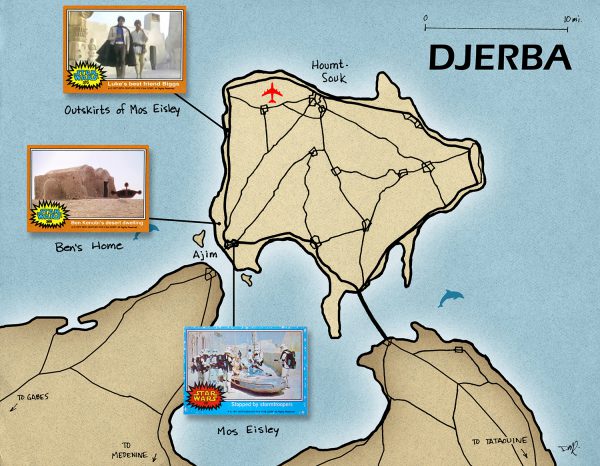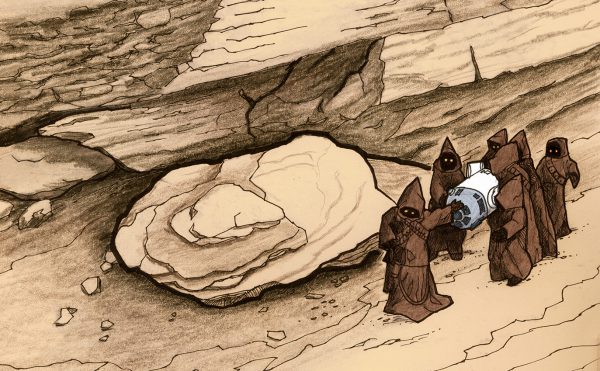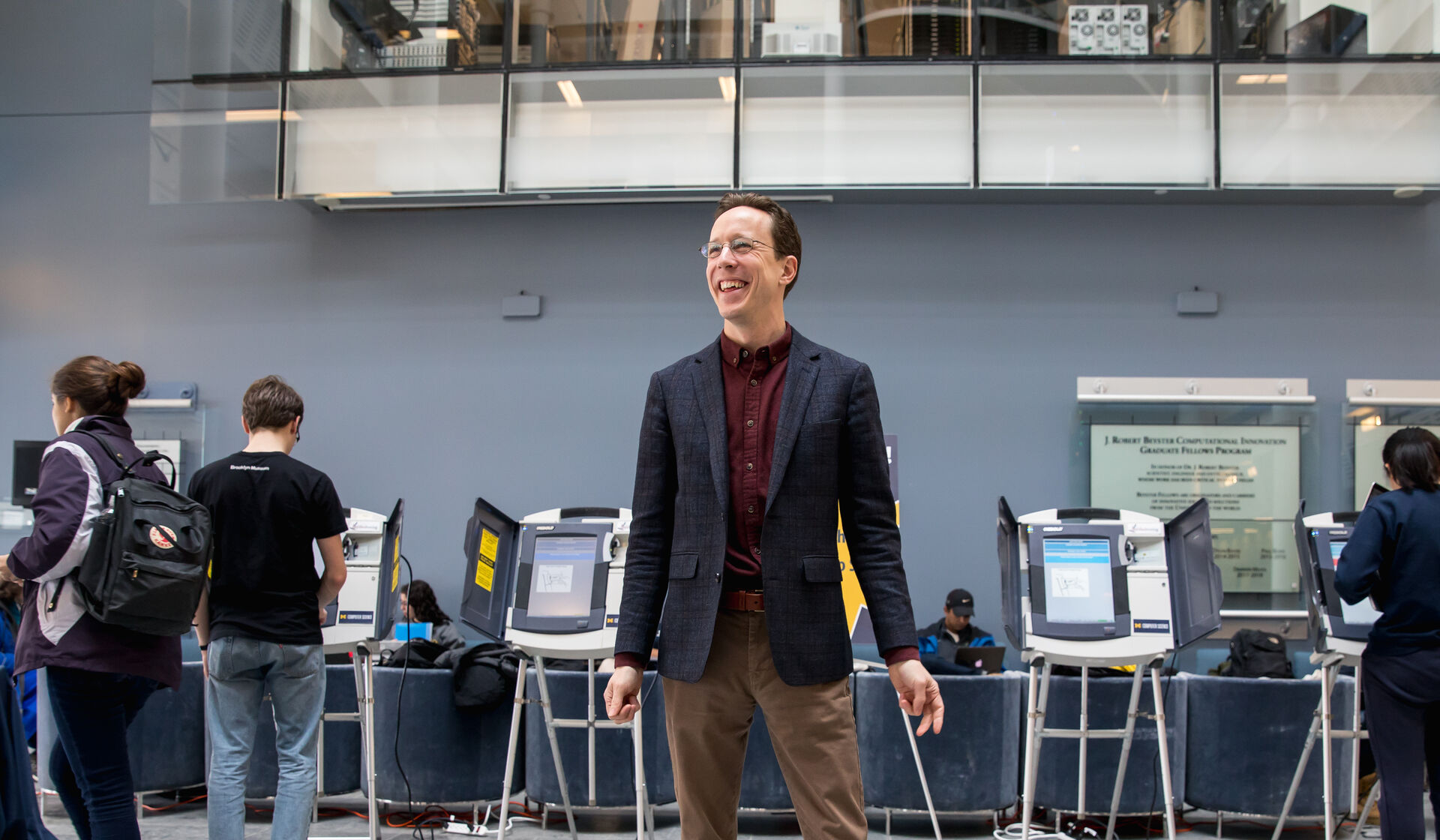The spring winds off the Tunisian desert are so intense that sweat evaporates almost instantly off the skin and it’s hard to hear the person next to you speaking. Yet David West Reynolds, MA’92, PhD’96, traveled there twice on archaeological expeditions seeking modern artifacts: sites where George Lucas had filmed “Star Wars” in 1976.
Reynolds first went to Tunisia in 1990 in search of the locations that had been “lost,” as no records had been kept, but he was unable to find them. When he returned in 1995, he was hoping archaeological techniques he learned at U-M would help. He studied Tunisian maps from the University’s library to find areas where sufficiently high rocky ridges offered the kinds of extremely rugged terrain seen in “Star Wars.” He calculated how far film crews could travel from the few large hotels. He then analyzed this information and found sites that existed in both categories.
“In these respects, I was inspired by the U-M dig project in Egypt that I participated in,” he said.
Several days into the project, he and a companion videographer observed a canyon. “I spotted an alcove that I remembered from the film. Finally, I knew we had the right canyon. That felt like hitting a home run and watching the ball sail out of the park.” They had, he said, finally “made it to ‘Tatooine’”—referring to the planet in the movie.

“At Matmata, the site of Luke Skywalker’s underground home, I was just hoping that the place would still be recognizable. I was delighted when I saw actual pieces of set decoration—futuristic-looking trim and plastic details—still in place around the openings of alcoves and tunnels in the central pit. The mural on the ceiling of the dining room that was used in a scene with Luke and his family was still there, unchanged!
“I was thrilled, because it felt like being so close to those moments I had experienced only on the movie screen,” he said. “Journey to Tataouine,” a one-hour documentary he produced on the discovery, is due out this month.
Reynolds is fascinated with the movie because he found it so believable. “It was so richly conceived and (in the original version) so convincingly realized on film that even under all my close examination, it still felt like exploring a real world. For an archaeologist type, that’s an extremely rare pleasure to enjoy.”
Following his discoveries, he wrote an article for Star Wars Insider, the official Lucasfilm magazine and was soon contacted by Rick McCallum, a producer who was preparing to visit Tunisia for the first “Star Wars” prequel, which became “Star Wars: The Phantom Menace.”
“McCallum contacted the Lucasfilm Archives for information, only to be told exactly what they told me”—that the sites had been lost, said Reynolds. “Then someone handed McCallum the magazine with my cover story on it. He took one look, said, ‘You have to be kidding me!’ and he soon had me on the phone.”
McCallum hired Reynolds as a guide to the locations. He then went to work for Lucasfilm on various projects.

He’s since left the company but has embarked on a diverse career as an author, consultant, and explorer. Among the seven books he has written about the film is “Star Wars: The Complete Visual Dictionary,” which became a New York Times best-seller. Those sales, he said, proved the theories he developed while working as a graduate student at the Exhibit Museum of Natural History, where he observed how the public reacted to the exhibits he and others designed.
“It was there I developed the communications theories that have given me so much later success.”
In his post-UM life, he has also revamped the derelict starwars.com website at Lucasfilm and quickly transformed it into one of the world’s top 100 websites by traffic.
He also contributed to the Hammond Atlas of World Religions, wrote a history of the Apollo space program (“Neil Armstrong wrote me a complimentary letter on my Apollo book. It was one of the highlights of my life!”), and formed a consultant company where he teamed up with colleagues from various backgrounds, including an FBI agent, to help clients more effectively communicate.
These endeavors came as no surprise to Joyce Marcus, his anthropology professor.
“From the beginning, I could see that David’s creativity and versatility would transcend any single academic discipline,” said Marcus. “He converted my raw measurements into three-dimensional drawings of ancient Peruvian buildings, now published many times. Other archaeologists often tell me that his art brings the buildings to life.”
“Star Wars” is not the only George Lucas film to make a deep impression on Reynolds.
“Because of ‘Raiders of the Lost Ark’ (written by fellow alum Lawrence Kasdan, ’70, MA’72, HLHD’00), I got a Ph.D. in archaeology, dug and explored in South America and Egypt,” says Reynolds. “I also learned to use a whip.”
He was hired as a consultant to track down the real history and archaeology behind Indiana Jones. “This project took me all over the world. I kept an illustrated journal as I traced the original ‘Raiders of the Lost Ark’ filming locations in Hawaii, Tunisia, and California as well as the historical sites where the ‘real’ 1936 Indiana Jones would have been in Peru, Cairo, Nepal, and elsewhere.”
But it all began with “Star Wars.”
Jon Caroulis is a writer who lives near Philadelphia and has written for many newspapers and magazines. “Raiders of the Lost Ark” is one of his favorite movies.





